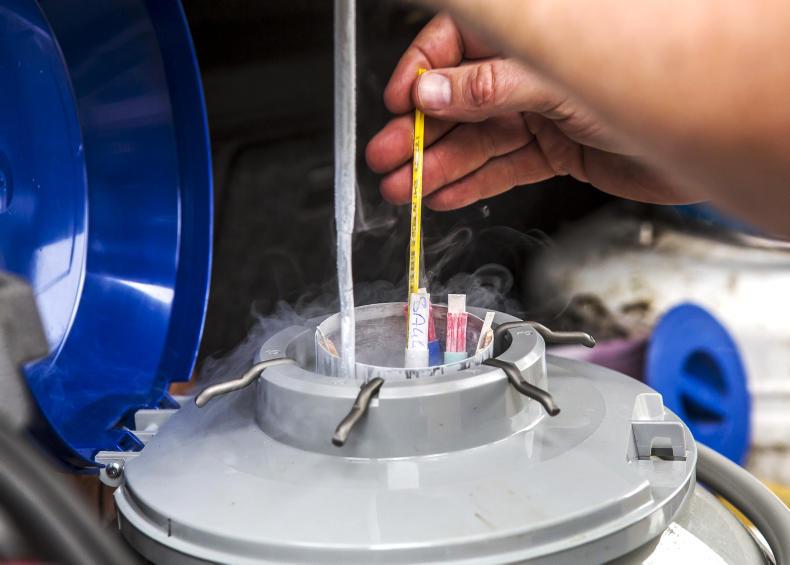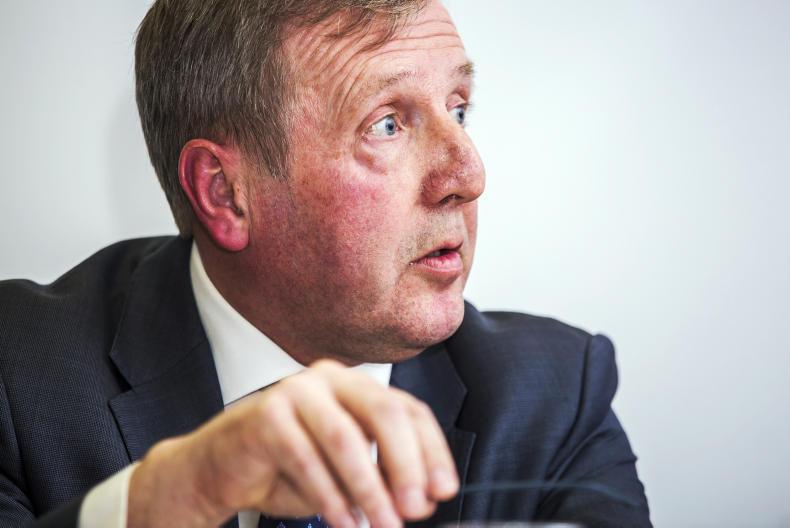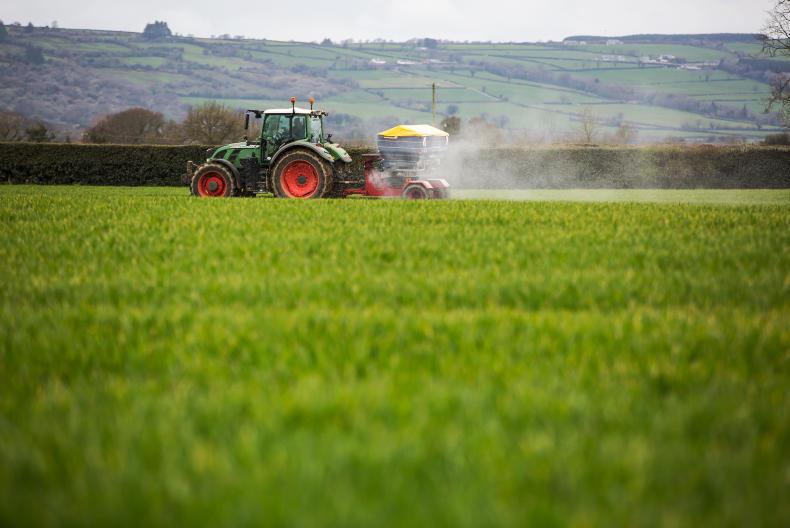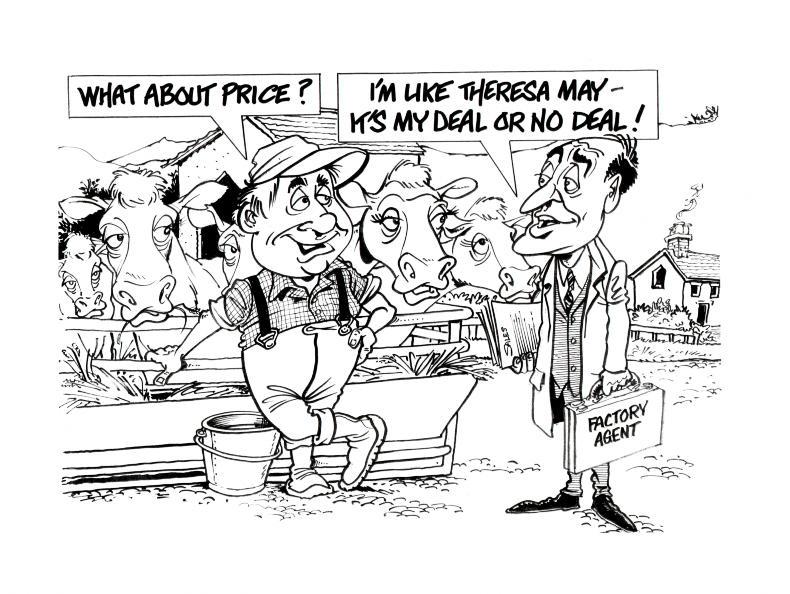How can the industry drive, promote and integrate the big-ticket items for farmer and industry sustainability? Financial and environmental sustainability are two items that rank highest.
The Department has schemes and incentives to subsidise items such as slurry tankers, buildings, etc. Should there be further new incentives to promote better breeding decisions on farm, so that per kilo of milk solids or meat produced, there is improved efficiency? Can using more AI drive real change in the farm finances and in environmental terms?
The biggest competition to artificial insemination (AI) remains the stock bull. Heat detection is another. For a very advanced sector in terms of knowledge and advisory uptake, the fact that one-third of dairy replacements are still bred by stock bull is hard to believe. The benefits of AI versus stock bull are well documented.
In EBI terminology, the ICBF’s Andrew Cromie reports that there remains a €100 difference in EBI between AI-bred and stock bull-bred replacements. That’s significant.
Similar to the dairy industry, AI-bred suckler stock can deliver higher suckler beef value. Again, the merits of the replacement index of commercial sucklers versus stock bull-bred stock are clear. At €30-€40 per cow, the benefits for farmers are probably not as measurable for the suckler herd but nevertheless evident.
One of the byproducts of a strong suckler breeding programme has been an excellent trade for AI-bred stock bulls going to Northern Ireland and Britain based on AI bloodlines used.
So what are the challenges for Irish AI companies? One of their biggest challenges is the compact nature of the AI season. A huge amount of investment in stock and facilities is now played out in a short number of weeks. Margin is also no doubt in focus for the AI companies. It’s fair to say this year we will see a swing to more beef AI, away from higher margin dairy AI straws, as more dairy farms reach maximum cow numbers.

In EBI terminology, the ICBF’s Andrew Cromie reports that there remains a €100 difference in EBI between AI-bred and stock bull-bred replacements. \ Philip Doyle
This week we launch our new Dairy Calf to Beef Programme with industry partners ICBF and Bord Bia, dairy companies Aurivo and Kerry, and AI companies Dovea Genetics, Munster and Progressive Genetics. All partners are key links in the chain, generating better quality beef bred cattle from dairy cows. The objective of the project is not research but to show what better beef genetics from the dairy herd can deliver in terms of better conformation and carcase quality. The lessons of calf rearing which many have forgotten will also be clearly outlined. Ultimately, we want genetics that can deliver more profit for the farmers investing in stock, facilities and feed.
For the last 15 years, dairy farmers have been inundated with messages on improving fertility and milk solids. The challenge now is smaller cows, short gestation and beef calves that don’t have the capacity to develop adequate carcase weight or quality to leave a return for rearers (see this week's Spring AI Focus).
Dairy farmers need ease of calving and short gestation while beef farmers need better carcase weights
Those rearing calves are not prepared to buy lower value dairy calves and this has in itself become a threat to the sustainability of the dairy drive. Better integration with the requirements of the beef industry are needed in order to minimise the number of low-value calves.
The ideal scenario would be to see rearing farms developing relationships with dairy farmers that use genetics they want, with arrangements in place even before the dairy herd are put back in calf.
There is also an onus on beef breeders to focus on breeding that will service this beef bred from the dairy herd as a genuine market. Dominated by Angus and Hereford in the past, this year is the first year of the new ICBF dairy beef index and we see other breeds appearing – such as Limousin and Belgian Blue sires – that can fill this opportunity. No doubt this index will develop as the years move on and more farmers use it.
Typically we are generating over 600,000 beef-bred animals out of the dairy herd and there is the possibility this could head for one million animals in the coming years. It is imperative we learn from the mistakes of the past and all calves must have an economic value.
Dairy farmers need ease of calving and short gestation while beef farmers need better carcase weights. Using AI-bred stock gives all farmers a better opportunity to hit these goals.
Without question, the right genetics are only one part of the breeding equation – management around heat detection, feeding, replacement strategy are equally as important.
Prices: beef farmers need action – not more reassurances
Beef cattle are being sold off farms at a loss of €200 to €300 per head. In some cases, farmers are now receiving €150 to €200 per head less than last year for the same quality animal.

We have heard reassurances again this week from Minister for Agriculture Michael Creed that “exceptional aid” would be provided to the beef sector in the wake of a no-deal Brexit. However, what is now obvious is that Brexit is not going to be a definitive event, but instead a continuous disruptive process that could last years.
It is illogical and disingenuous for the Government and European Commission not to accept that the cost of this prolonged and disruptive process is already crippling incomes in the beef sector. Beef farmers are caught in the crossfire of highly volatile exchange rates and severe disruption to normalised trade flows. We see similar signs on dairy trade.
Beef factories are simply passing the cost of both back down to finishers through lower cattle prices. There is also strong evidence to suggest that the disruption of Brexit is being used as a smokescreen to drive up profit margins, particularly when we look at how Irish processors have collapsed the price paid for young bulls.
Despite the severe economic pressure and the lack of Government action, the response at all levels has been at best muted. There is a point at which a crisis moves beyond merely issuing statements and holding meetings. It is time to force the Government and the European Commission to take action.
The Government and Commission have repeatedly reassured farmers that these tools, available under the Common Market Orientation (CMO), exist to protect their income from Brexit. It is time for both parties to stop waiting for a Brexit outcome and accept that the beef sector needs these tools to be introduced now.
The immediate option open to the Government is to trigger an aid package to beef farmers under the De Minimis regulation. This allows the minister to provide emergency compensation to farmers up to a value of €25,000. While only a sticking plaster, it would provide some breathing space for beef finishers that are haemorrhaging money at present.
These farmers don’t need more lofty statements or feelgood reassurances – they need immediate action from all parties if they are to survive this spring.
Sustainability: emissions in focus

The link between economic, social and environmental performance – the three pillars of farm sustainability – is now clearly established. This creates opportunity: lifting all farmers to the level of top performers is shown to benefit them financially and create better social conditions for them and their family, while producing food that carries a lower carbon footprint per unit produced.
Some striking facts arise from the Teagasc sustainability report. At under 2t/ha of carbon dioxide equivalent emitted in 2017, tillage farms had half the carbon footprint of drystock ones and four times less than dairy farms. This highlights the need to halt the shrinkage of our tillage sector. These statistics ignore the carbon sequestration benefits of grassland and the fact that this subset of farmers can actually plant more trees to help the carbon balance equation.
Yet Teagasc’s data highlights challenges too. The most efficient farmers are those who work the longest hours and have higher stocking rates. Dairy farmers are also responsible for a higher volume of overall greenhouse gas emissions, but it is worth remembering that milk from these farms feeds people all over the world. Teagasc sees them as priority targets for the implementation of key measures among the 27 identified last year.
The Oireachtas Joint Committee on Climate Action is expected to endorse this plan on Thursday. These recommendations should form the roadmap for EU schemes in the future.
Contractors: benefits of scale
In our Machinery supplement, it is crystal clear the critical role contractors play as an important cog in the modern farm business. Scale allows the capacity to invest in better equipment that is safer for the operator. Scale also allows for the investment in new technology that often has additional environmental benefits for handling slurry, etc.
How can the industry drive, promote and integrate the big-ticket items for farmer and industry sustainability? Financial and environmental sustainability are two items that rank highest.
The Department has schemes and incentives to subsidise items such as slurry tankers, buildings, etc. Should there be further new incentives to promote better breeding decisions on farm, so that per kilo of milk solids or meat produced, there is improved efficiency? Can using more AI drive real change in the farm finances and in environmental terms?
The biggest competition to artificial insemination (AI) remains the stock bull. Heat detection is another. For a very advanced sector in terms of knowledge and advisory uptake, the fact that one-third of dairy replacements are still bred by stock bull is hard to believe. The benefits of AI versus stock bull are well documented.
In EBI terminology, the ICBF’s Andrew Cromie reports that there remains a €100 difference in EBI between AI-bred and stock bull-bred replacements. That’s significant.
Similar to the dairy industry, AI-bred suckler stock can deliver higher suckler beef value. Again, the merits of the replacement index of commercial sucklers versus stock bull-bred stock are clear. At €30-€40 per cow, the benefits for farmers are probably not as measurable for the suckler herd but nevertheless evident.
One of the byproducts of a strong suckler breeding programme has been an excellent trade for AI-bred stock bulls going to Northern Ireland and Britain based on AI bloodlines used.
So what are the challenges for Irish AI companies? One of their biggest challenges is the compact nature of the AI season. A huge amount of investment in stock and facilities is now played out in a short number of weeks. Margin is also no doubt in focus for the AI companies. It’s fair to say this year we will see a swing to more beef AI, away from higher margin dairy AI straws, as more dairy farms reach maximum cow numbers.

In EBI terminology, the ICBF’s Andrew Cromie reports that there remains a €100 difference in EBI between AI-bred and stock bull-bred replacements. \ Philip Doyle
This week we launch our new Dairy Calf to Beef Programme with industry partners ICBF and Bord Bia, dairy companies Aurivo and Kerry, and AI companies Dovea Genetics, Munster and Progressive Genetics. All partners are key links in the chain, generating better quality beef bred cattle from dairy cows. The objective of the project is not research but to show what better beef genetics from the dairy herd can deliver in terms of better conformation and carcase quality. The lessons of calf rearing which many have forgotten will also be clearly outlined. Ultimately, we want genetics that can deliver more profit for the farmers investing in stock, facilities and feed.
For the last 15 years, dairy farmers have been inundated with messages on improving fertility and milk solids. The challenge now is smaller cows, short gestation and beef calves that don’t have the capacity to develop adequate carcase weight or quality to leave a return for rearers (see this week's Spring AI Focus).
Dairy farmers need ease of calving and short gestation while beef farmers need better carcase weights
Those rearing calves are not prepared to buy lower value dairy calves and this has in itself become a threat to the sustainability of the dairy drive. Better integration with the requirements of the beef industry are needed in order to minimise the number of low-value calves.
The ideal scenario would be to see rearing farms developing relationships with dairy farmers that use genetics they want, with arrangements in place even before the dairy herd are put back in calf.
There is also an onus on beef breeders to focus on breeding that will service this beef bred from the dairy herd as a genuine market. Dominated by Angus and Hereford in the past, this year is the first year of the new ICBF dairy beef index and we see other breeds appearing – such as Limousin and Belgian Blue sires – that can fill this opportunity. No doubt this index will develop as the years move on and more farmers use it.
Typically we are generating over 600,000 beef-bred animals out of the dairy herd and there is the possibility this could head for one million animals in the coming years. It is imperative we learn from the mistakes of the past and all calves must have an economic value.
Dairy farmers need ease of calving and short gestation while beef farmers need better carcase weights. Using AI-bred stock gives all farmers a better opportunity to hit these goals.
Without question, the right genetics are only one part of the breeding equation – management around heat detection, feeding, replacement strategy are equally as important.
Prices: beef farmers need action – not more reassurances
Beef cattle are being sold off farms at a loss of €200 to €300 per head. In some cases, farmers are now receiving €150 to €200 per head less than last year for the same quality animal.

We have heard reassurances again this week from Minister for Agriculture Michael Creed that “exceptional aid” would be provided to the beef sector in the wake of a no-deal Brexit. However, what is now obvious is that Brexit is not going to be a definitive event, but instead a continuous disruptive process that could last years.
It is illogical and disingenuous for the Government and European Commission not to accept that the cost of this prolonged and disruptive process is already crippling incomes in the beef sector. Beef farmers are caught in the crossfire of highly volatile exchange rates and severe disruption to normalised trade flows. We see similar signs on dairy trade.
Beef factories are simply passing the cost of both back down to finishers through lower cattle prices. There is also strong evidence to suggest that the disruption of Brexit is being used as a smokescreen to drive up profit margins, particularly when we look at how Irish processors have collapsed the price paid for young bulls.
Despite the severe economic pressure and the lack of Government action, the response at all levels has been at best muted. There is a point at which a crisis moves beyond merely issuing statements and holding meetings. It is time to force the Government and the European Commission to take action.
The Government and Commission have repeatedly reassured farmers that these tools, available under the Common Market Orientation (CMO), exist to protect their income from Brexit. It is time for both parties to stop waiting for a Brexit outcome and accept that the beef sector needs these tools to be introduced now.
The immediate option open to the Government is to trigger an aid package to beef farmers under the De Minimis regulation. This allows the minister to provide emergency compensation to farmers up to a value of €25,000. While only a sticking plaster, it would provide some breathing space for beef finishers that are haemorrhaging money at present.
These farmers don’t need more lofty statements or feelgood reassurances – they need immediate action from all parties if they are to survive this spring.
Sustainability: emissions in focus

The link between economic, social and environmental performance – the three pillars of farm sustainability – is now clearly established. This creates opportunity: lifting all farmers to the level of top performers is shown to benefit them financially and create better social conditions for them and their family, while producing food that carries a lower carbon footprint per unit produced.
Some striking facts arise from the Teagasc sustainability report. At under 2t/ha of carbon dioxide equivalent emitted in 2017, tillage farms had half the carbon footprint of drystock ones and four times less than dairy farms. This highlights the need to halt the shrinkage of our tillage sector. These statistics ignore the carbon sequestration benefits of grassland and the fact that this subset of farmers can actually plant more trees to help the carbon balance equation.
Yet Teagasc’s data highlights challenges too. The most efficient farmers are those who work the longest hours and have higher stocking rates. Dairy farmers are also responsible for a higher volume of overall greenhouse gas emissions, but it is worth remembering that milk from these farms feeds people all over the world. Teagasc sees them as priority targets for the implementation of key measures among the 27 identified last year.
The Oireachtas Joint Committee on Climate Action is expected to endorse this plan on Thursday. These recommendations should form the roadmap for EU schemes in the future.
Contractors: benefits of scale
In our Machinery supplement, it is crystal clear the critical role contractors play as an important cog in the modern farm business. Scale allows the capacity to invest in better equipment that is safer for the operator. Scale also allows for the investment in new technology that often has additional environmental benefits for handling slurry, etc.









 This is a subscriber-only article
This is a subscriber-only article













SHARING OPTIONS: